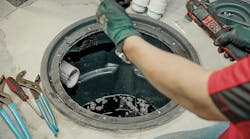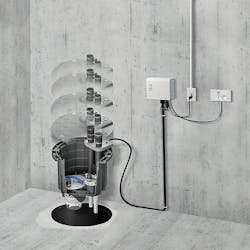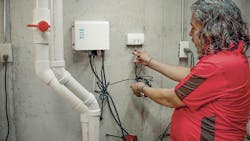For over a century, submersible pumps have revolutionized the transportation of water, waste, and liquids, surpassing traditional methods and becoming an integral component of residential, commercial, and industrial sectors alike. These pumps, designed to be placed directly in the fluid they are pumping, overcame the limitations of older systems and offered a more efficient and reliable solution.
Smaller submersible pump units called "sewage ejectors" are typically used in home and light commercial applications. Introduced in the early 20th century, sewage ejectors provided an alternative to traditional gravity-based systems, allowing sewage collection and expulsion from low-lying areas or where the natural slope was insufficient. The introduction of sewage ejectors marked a significant milestone in sewage management's evolution, revolutionizing how wastewater is handled and paving the way for future advancements in the field.
However, the field of sewage ejectors has experienced a noticeable dearth of innovation since its introduction. With homes beginning to show wear and tear, this lack of progress has resulted in limited improvements and limited options for professionals in the sewage industry.
As a consequence, there exists a pressing need for renewed focus and innovation to address challenges, such as frequent float switch failures and clogs and messy repairs for service contractors.
Too Soon to Fail
The lifespan of sewage ejectors is a concern for many industry professionals. Generally, these devices have a lifespan of around 7 to 10 years. However, a common issue during this timeframe is the malfunctioning of the float switch component.
The float switch, responsible for controlling the pump's activation and deactivation, often fails after two to five years of usage. This frequent occurrence has become a well-known challenge in the field, prompting users to anticipate and prepare for the potential need for repair or replacement within a relatively short span. Addressing this issue is crucial to ensure the continued reliable operation of sewage ejectors and to minimize disruptions in wastewater management systems.
Here are other common challenges of existing sewage ejectors:
● Frequent clogging and jamming: Sewage ejector pumps move wastewater from lower to higher elevations. In the process, they can encounter solid waste and a potential excess of sanitary napkins or toilet paper, which can cause blockages. If the pump is not properly equipped or maintained, these blockages can disrupt the flow of wastewater and result in backups and overflows, causing potential health hazards and property damage.
● Frequent occurrence of system failures: Sewage ejector pumps can experience mechanical issues, such as motor or pump malfunctions, leading to pump failure and ineffective wastewater conveyance. Furthermore, improper installation or sizing of the pump can also contribute to system failures, as it may need more capacity to handle the volume and pressure requirements.
● Frequent repairs with high maintenance costs: Over time, these sewage ejector pumps can become prone to issues such as motor burnout, worn-out seals, or, as mentioned, malfunctioning float switches. These problems can result in pump failures, leading to sewage backups and potential health hazards. The costs of frequent repairs, including parts and labor, can quickly add up. Moreover, the inconvenience and disruption caused by repeated breakdowns can frustrate homeowners or property managers.
● Messy Repairs: Traditional sewage ejector pumps can be difficult, dirty and time-consuming to repair and may require extensive professional assistance. Complex repairs may even involve digging up floors to access and replace the pump. Furthermore, the mess and odors associated with sewage pump repairs can be unpleasant and unhealthy.
Alternative Solution
Dominick Rudd, a seasoned plumber at Bush Plumbing outside Indianapolis, has successfully implemented the SFA Saniflo Sanipit 24 GR retrofit pump kit as a reliable solution for replacing faulty sewage ejectors. This innovative product is compatible with existing 24-inch basins from major manufacturers like Liberty Pumps, Zoeller, and Myers, simplifying installation without extensive modifications.
Rudd praises the Sanipit for its easy installation, maintenance convenience, and dry-cavity design that separates the motor from sewage. The built-in, 1-horsepower grinder motor efficiently handles waste, improving performance and customer satisfaction. Rudd highlights the pump's easy access for maintenance and its long lifespan, promising minimal upkeep and fewer replacements for homeowners.
Benefits for Contractors and Homeowners
By incorporating the Sanipit 24 GR retrofit pump kit into his projects, Rudd is poised to overcome the common challenges associated with sewage ejectors across North America.
For homeowners, the enhanced performance, reliability, and ease of use translate to an improved living experience with fewer risks.
Meanwhile, contractors like Rudd benefit from simplified installations, reduced maintenance requirements, and the ability to offer cost-effective solutions to their clients.
Notably, the Sanipit 24 GR retrofit pump kit aligns perfectly with Bush Plumbing’s commitment to providing its customers with top-notch service and innovative solutions. By leveraging the kit’s features and benefits, Rudd and the Bush team deliver value to their clients, enhancing their company’s reputation as trusted plumbing experts.
With a four-year warranty, Homeowners can now enjoy peace of mind, knowing that their waste management systems are dependable and efficient. At the same time, contractors like Rudd have found a cost-effective, reliable replacement solution that streamlines their work and enhances their professionalism.
Luis Arias has been working for SFA Saniflo for 15 years as Inside Technical Sales. His vast knowledge of pump systems and the plumbing trade has been used on many large-scale projects. Luis has contributed to the overall company success by working directly with architects, engineers, and trade professionals on engineering bids.




